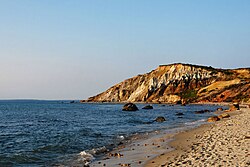Wampanoag Tribe of Gay Head

Gay Head Cliffs, Aquinnah, Martha's Vineyard
|
|
| Total population | |
|---|---|
| 1,121 | |
| Regions with significant populations | |
|
|
|
| Languages | |
| English, Wampanoag | |
| Religion | |
| traditional tribal religion | |
| Related ethnic groups | |
| other Wampanoag people |
The Wampanoag Tribe of Gay Head (Aquinnah) is a federally recognized tribe of Wampanoag people based in the town of Aquinnah on the southwest tip of Martha's Vineyard in Massachusetts. The tribe hosts an annual Cranberry Day celebration.
The tribe received official recognition in 1987, the same year that their land claim on Martha's Vineyard was settled by an act of Congress, with agreement by the state and the United States Department of Interior. The government took into trust on behalf of the tribe 485 acres of Tribal Lands purchased (160 acres private and approximately 325 acres common lands). In 2011 the state of Massachusetts passed a law allowing legalized gambling, and federally recognized Native American tribes began to develop proposals to develop casinos.
Faced with state opposition to a Class III facility on its land, in 2013 the Wampanoag Tribe of Gay Head proposed a Class II facility to be developed on its property. The state and town filed suit against it in federal district court, and the judge ruled in their favor. The tribe, together with the Department of Interior, appealed to the US Court of Appeals, First Circuit, defending its case in December 2016.
The Wampanoag Tribe of Gay Head is governed by an elected eleven-member council. The current administration is as follows.
The tribe also has a hereditary traditional chief and a medicine man, who both hold their positions for life.
The Aquinnah Wampanoag tribe operates a shellfish hatchery on Menemsha Pond, cultivating oysters. Tourism is also very important to the tribe. Many tribal members own their own businesses, while others have had to move off island for employment.
Wampanoag people have lived in the area of Aquinnah, Massachusetts, for millennia. Traditionally, they fished, grew crops, and hunted whales. English people began settling in the region in large numbers by the 17th and 18th centuries, encroaching on Wampanoag lands. Over time the Wampanoag were dispossessed of their lands. Some intermarried with English colonists and later European-American generations. As the Wampanoag had a matrilineal kinship system, they considered all children born to their women to be Wampanoag. They carried on their culture this way. Descent and inheritance passed through the women's lines.
...
Wikipedia
